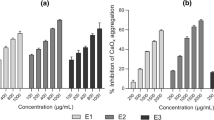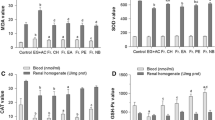Abstract
Copaifera langsdorffii Desf. commonly known as “copaíba”, produce a commercially valuable oil-resin that is extensively used in folk medicine for anti-inflammatory, antimicrobial and antiseptic purposes. We have found the hydroalcoholic extract of this plant leaf has the potential to treat urolithiasis, a problem affecting ~7% of the population. To isolate the functional compounds C. langsdorffii leaves were dried, ground, and macerated in a hydroalcoholic solution 7:3 to produce a 16.8% crude extract after solvent elimination. Urolithiasis was induced by introduction of a calcium oxalate pellet (CaOx) into the bladders of adult male Wistar rats. The treated groups received the crude extract by oral gavage at 20 mg/kg body weight daily for 18 days. Extract treatment started 30 days after CaOx seed implantation. To monitor renal function sodium, potassium and creatinine concentrations were analyzed in urine and plasma, and were found to be in the normal range. Analyses of pH, magnesium, phosphate, calcium, uric acid, oxalate and citrate levels were evaluated to determine whether the C. langsdorffii extract may function as a stone formation prevention agent. The HPLC analysis of the extract identified flavonoids quercitrin and afzelin as the major components. Animals treated with C. langsdorffii have increased levels of magnesium and decreased levels of uric acid in urinary excretions. Treated animals have a significant decrease in the mean number of calculi and a reduction in calculi mass. Calculi taken from extract treated animals were more brittle and fragile than calculi from untreated animals. Moreover, breaking calculi from untreated animals required twice the amount of pressure as calculi from treated animals (6.90 ± 3.45 vs. 3.00 ± 1.51). The extract is rich in flavonoid heterosides and other phenolic compounds. Therefore, we hypothesize this class of compounds might contribute significantly to the observed activity.

Similar content being viewed by others
References
Newman DJ, Cragg GM (2007) Natural products as sources of new drugs over the last 25 years. J Nat Prod 70:461–477
Paiva LAF, Gurgel LA, De Sousa ET et al (2004) Protective effect of Copaifera langsdorffii oleo-resin against acetic acid-induced colitis in rats. J Ethnopharmacol 93:51–56
Cavalcanti BC, Costa-lotufo LV, Moraes MO et al (2006) Genotoxicity evaluation of kaurenoic acid, a bioactive diterpenoid present in Copaiba oil. Food Chem Tox 44:388–392
Gomes NM, Rezende CM, Fontes SP, Matheus ME, Fernandes PD (2007) Antinociceptive activity of Amazonian Copaíba oils. J Ethnopharmacol 109:486–492
Paiva LAF, Gurgel LA, Silva RM et al (2003) Anti-inflammatory effect of kaurenoic acid, a diterpene from Copaifera langsdorffii on acetic acid-induced colitis in rats. Vascular Pharmacol 39:303–307
Souza AB, Martins CHG, Souza MGM, et al (2010) Antimicrobial activity of terpenoids from Copaifera langsdorffii Desf. against cariogenic bacteria. Phytother Res. doi:10.1002/ptr.03244)
Paiva LAF, Gurgel LA, Campos AR, Silveira ER, Rao VSN (2004) Attenuation of ischemia/reperfusion-induced intestinal injury by oleoresin from Copaifera langsdorfii in rats. Life Sci 75:1979–1987
Paiva LAF, Rao VSN, Gramosa NV, Silveira ER (1998) Gastroprotective effect of Copaifera langsdorffii oleo-resin on experimental gastric ulcer models in rats. J Ethnopharmacol 62:73–78
Grases F, Costa-Bauzá A, Prieto RM (2006) Renal lithiasis and nutrition. Nut J 5:23–29
Merchant ML, Cummins TD, Wilkey DW et al (2008) Proteomic analysis of renal calculi indicates an important role for inflammatory processes in calcium stone formation Am J Physiol Renal Physiol 295(4):1254–1258
Barros ME, Lima R, Mercuri LP, Matos JR, Schor N, Boim MA (2006) Effect of extract of Phyllanthus niruri on crystal deposition in experimental urolithiasis. Urol Res 34:351–357
Karadi RV, Gadge NB, Alagawadi KR, Savadi RV (2006) Effect of Moringa oleifera Lam. root-wood on ethylene glycol urolithiasis in rats. J Ethnopharmacol 105:306–311
Moe OW (2006) Kidney stones: pathophysiology and medical management. Lancet 367:333–344
Ettinger B, Tang A, Citron JT, Livermore B, Williams T (1986) Randomized trial of allopurinol in the prevention of calcium oxalate calculi. N Engl J Med 315:1386–1389
Gettman MT, Segura JW (1999) Struvite stones diagnosis and current treatment concepts. J Endourol 13:653–658
Prasad KVSRG, Sujatha D, Bharathi K (2007) Herbal drugs in urolithiasis—a review. Pharmacog Rev 1:175–179
Singh CM, Sachan SS (1989) Management of urolithiasis by herbal drugs. J Nepal Pharm Assoc 7:81–85
Anand R, Patnaik GK, Kulshreshtha DK (1994) Antiurolithiac activity of lupeol, the active constituent isolated from Crataeva nurvala. Phytother Res 8:417–421
Sannidi DN, Kumar A, Kumar N (1997) To evaluate the effect of Ayuervedic drugs Sveta parpati with pashanabheda and Gokshura in the management of Mutrasmari. P of Natl Sc Counc, Part B. Life Sci 21:13–19
Viel TA, Monteiro APS, Landman MTRL, Lapa AJ, Souccar C (1994) Evaluation of antiurolithiac activity of the extract of Costus spiralis Roscoe in rats. J Ethnopharmacol 66:193–198
de Sousa JPB, Brancalion APS, Júnior MG, Bastos JK (2011) A validated chromatographic method for the determination of quercetin, kaempferol and three flavonol glycosides in Copaifera langsdorffii by HPLC. Nat Prod Commun 6:1–3
Archer HE, Dormer AE, Scowen EF, Watts RWE (1957) Studies on the urinary excretion of oxalate by normal subjects. Clin Sci 16:405
Lewis BD (1990) Determination of citrate in urine by simple direct photometry. Clin Chem 36:578
Sobrinho TJSP, Gomes TLB, Cardoso CM, Amorim ELC (2010) Optimization of analytic methodologies for quantifying flavonoids of Bauhinia cheilantha (bongard) steudel. Quim Nova 33:288–291
Perez RM, Vargas R, Perez S, Zavala MA, Perz C (2000) Antiurolithiatic activity of 7-hydroxy-2′, 4′, 5′-threemethoxyisoflavone and 7-hydroxy-4′-methoxyisoflavone from Eysenhardtia polystachya. J Herbs Spices Med Plants 7:27–34
Laroubi A, Touhami M, Farouk L, Zrara I, Aboufatima R, Benharrel A, Chait A (2007) Prophylaxis effect of Trigonella foenum graecum L. seeds on renal stone formation in rats. Phytother Res 21:921–925
Bushinsky DA, Neumann KJ, Asplin J, Krieger NS (1999) Alendronate decreases urine calcium and supersaturation in genetic hypercalciuric rats. Kidney Int 55:234–243
Tanzeer K, Rakesh KB, Surinder KS, Chanderdeep T (2009) In vivo efficacy of Trachyspermum ammi anticalcifying protein in urolithiatic rat model. J Ethnopharmacol 126:459–462
Ogawa Y, Miyazato T, Hatano T (1999) Importance of oxalate precursors for oxate metabolism in rats. J Am Soc Nephrol 10:341–344
Vermeulen CW, Grove WJ, Goetz R, Ragins HD, Correll NO (1950) Experimental urolithiasis. I. Development of calculi upon foreign bodies surgically introduced into bladders of rats. J Urol 64(4):541–548
Li MK, Blacklok NJ, Garside J (1985) Effects of magnesium on calcium oxalate crystallization. J Urol 133:123–125
Brunharoto ARF, Flores CBJr, Flores BLP, Bastos JK, Carvalho JCT (2005) Process to obtain extracts, fractions and isolated compounds from Copaifera species and their use for the treatment of urinary lithiasis in humans and animals. PCT Int Appl, pp 14. CODEN: PIXXD2 WO 2005110446 A1 20051124 CAN 143:483059 AN 2005:1239298 CAPLUS
Acknowledgments
We are grateful to FAPESP grant # 2008/57775-5 for the financial support.
Author information
Authors and Affiliations
Corresponding author
Rights and permissions
About this article
Cite this article
Brancalion, A.P.S., Oliveira, R.B., Sousa, J.P.B. et al. Effect of hydroalcoholic extract from Copaifera langsdorffii leaves on urolithiasis induced in rats. Urol Res 40, 475–481 (2012). https://doi.org/10.1007/s00240-011-0453-z
Received:
Accepted:
Published:
Issue Date:
DOI: https://doi.org/10.1007/s00240-011-0453-z




